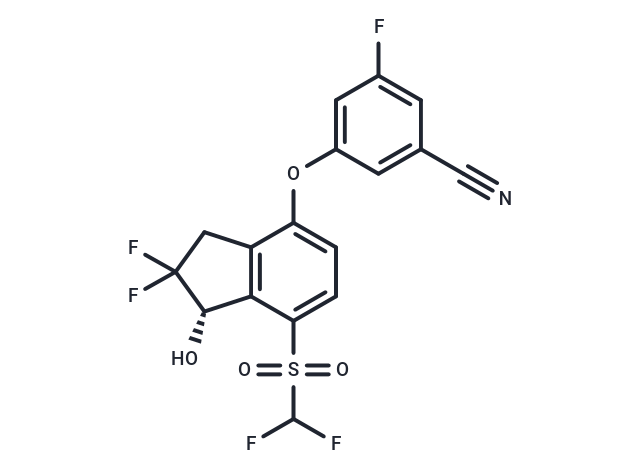Shopping Cart
Remove All Your shopping cart is currently empty
Your shopping cart is currently empty
PT2399 is a first-in-class, orally available, small molecule inhibitor of HIF-2 that selectively disrupts the heterodimerization of HIF-2α with HIF-1β. PT2399 displays potent antitumor activity in vivo

| Pack Size | Price | USA Warehouse | Global Warehouse | Quantity |
|---|---|---|---|---|
| 1 mg | $95 | In Stock | In Stock | |
| 5 mg | $235 | In Stock | In Stock | |
| 10 mg | $353 | In Stock | In Stock | |
| 25 mg | $639 | In Stock | In Stock | |
| 50 mg | $943 | In Stock | In Stock | |
| 100 mg | $1,320 | - | In Stock | |
| 1 mL x 10 mM (in DMSO) | $258 | In Stock | In Stock |
| Description | PT2399 is a first-in-class, orally available, small molecule inhibitor of HIF-2 that selectively disrupts the heterodimerization of HIF-2α with HIF-1β. PT2399 displays potent antitumor activity in vivo |
| Targets&IC50 | HIF2α:6 nM |
| In vitro | PT2399, a selective HIF-2 antagonist that was identified using a structure-based design approach. PT2399 dissociated HIF-2 (an obligatory heterodimer of HIF-2α-HIF-1β) in human ccRCC cells and suppressed tumorigenesis in 56% (10 out of 18) of such lines[1].PT2399 inhibits HIF-2α (IC50: 6 nM). PT2399 represses various HIF target genes in 786-O VHL / ccRCC cells, does not suppress HIF-1α-specific targets such as BNIP3. PT2399 can cripple HIF-2α’s ability to bind to Aryl hydrocarbon receptor nuclear translocator (ARNT). PT2399 (20 μM) induces off-target toxicity because it inhibits the proliferation of HIF-2α / 786-O cells and other cancer cell lines with undetectable HIF-2α. PT2399 (0.2–2 μM; 0-21 days) inhibits 786-O cells soft agar growth[2][3]. |
| In vivo | PT2399) that directly inhibits HIF-2α causes tumour regression in preclinical mouse models of primary and metastatic pVHL-defective clear cell renal cell carcinoma in an on-target fashion[2].PT2399 inhibits tumor cell proliferation 3.5 fold in renal cell carcinoma (RCC) bearing mice.PT2399 directly inhibits HIF-2α causes tumor regression in preclinical models of primary and metastatic pVHL-defective ccRCC in an on-target fashion.PT2399 reduces tumor cell density and increases fibrosis in RCC bearing mice.PT2399 (100 mg/kg;oral gavage;every 12 hours) is more active than SU 11248 and inhibits tumor growth in several SU 11248-resistant tumors in RCC bearing mice [1][2]. |
| Molecular Weight | 419.32 |
| Formula | C17H10F5NO4S |
| Cas No. | 1672662-14-4 |
| Smiles | O[C@H]1c2c(CC1(F)F)c(Oc1cc(F)cc(c1)C#N)ccc2S(=O)(=O)C(F)F |
| Relative Density. | no data available |
| Color | White |
| Appearance | Solid |
| Storage | store at low temperature,store under nitrogen | Powder: -20°C for 3 years | In solvent: -80°C for 1 year | Shipping with blue ice/Shipping at ambient temperature. | |||||||||||||||||||||||||||||||||||
| Solubility Information | DMSO: 262.5 mg/mL (626.01 mM), Sonication is recommended. | |||||||||||||||||||||||||||||||||||
| In Vivo Formulation | 10% DMSO+40% PEG300+5% Tween 80+45% Saline: 5 mg/mL (11.92 mM), Sonication is recommended. Please add the solvents sequentially, clarifying the solution as much as possible before adding the next one. Dissolve by heating and/or sonication if necessary. Working solution is recommended to be prepared and used immediately. The formulation provided above is for reference purposes only. In vivo formulations may vary and should be modified based on specific experimental conditions. | |||||||||||||||||||||||||||||||||||
Solution Preparation Table | ||||||||||||||||||||||||||||||||||||
DMSO
| ||||||||||||||||||||||||||||||||||||
| Size | Quantity | Unit Price | Amount | Operation |
|---|

Copyright © 2015-2025 TargetMol Chemicals Inc. All Rights Reserved.